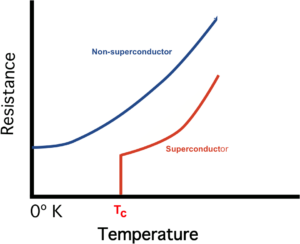What is an electrical conductor?
A material that permits the flow of electrical current is referred to as an electrical conductor.
There are a variety of electrical conductors, but we will be focusing on two types which are semiconductors and superconductors.
The key difference between a semiconductor and superconductor is that the conductivity of a semiconductor ranges between the conductivity of a conductor and insultator, whereas a superconductor has a conductivity that is higher than that of a conductor but at a specific temperature.
We will now look at further differences between the two as well as go into details for each type.
Differences Chart
| Semiconductors | Superconductors | |
| General
|
Due to moderate offered resistance, they offer lower conductivity than conductors | Due to zero offered resistance, they offer higher conductivity than conductors |
| Electrical Conductivity Range | Between conductors and insulators | Higher than conductors |
| Energy Consumption | Moderate | Insignificant |
| Band Gap | 0.25 to 2.5 eV | Above 2.5 eV |
| Examples | Silicon, Germanium, Selenium, etc. | Aluminum, Niobium, Bismuth, etc. |
Definitions of Semiconductor and Superconductor
In order to understand the differences between these two types of conductors, we need to take a bit of a deep dive into the details of each conductor type.
Semiconductor
Semiconductors are the materials whose conductivity is lower than conductors but higher than insulators. This makes them neither good conductors nor good insulators.
These materials, which are frequently crystalline solids, are employed in several industries to produce items like integrated circuits, diodes, and transistors.
The conductivity of a semiconductor is often sensitive to elements like temperature, light, magnetic fields, impurities in the semiconductor material, etc.
Adding impurity to a pure semiconductor material allows for a greater conductivity to be achieved as a pure semiconductor itself doesn’t have an accurate conductivity. This is how semiconductors are classified as well.
Semiconductors are classified based on the type of impurity that is added to them. The two classifications of semiconductors are p-type and n-type semiconductors.
![]()
There exists an energy gap between the conduction and valence bands of the semiconductor. This is called the band gap.
For the current to flow, the majority charge carriers need to move from the valance band to the conduction band.
As mentioned in the table above, the bandgap for semiconductors is usually less than 2eV and so the current can flow after the electrons gain a sufficient amount of energy.
As temperature increases, conduction increases and resistance decreases, since there is now an increased energy gain by charged carriers.
Superconductors
Superconductors are the materials whose conductivity is higher than conductors at a certain temperature.
A superconductor is a material that loses all its resistivity when it is cooled below a certain temperature.
This means that a superconductor, at a certain temperature, allows the flow of current through it without any loss of energy.

These materials lose all their resistivity at a certain temperature which is called the critical temperature or Tc.
The resistivity of normal conductors rises as their temperature rises, therefore a decrease in temperature lowers the resistance.
However, this resistance has a particular value at the lowest temperature.
Therefore, superconductors are the materials whose resistance drops to zero unexpectedly at a specific temperature.
There are two classifications of superconductors: Type I and Type II superconductors
Type I superconductors act as conductors at room temperature and attain superconductivity when the temperature drops below Tc.
Type II superconductors are not good conductors at room temperature but become superconductors once they reach Tc.
Summarizing Semiconductors vs Superconductors
1) Semiconductors exhibit moderate conductivity, Superconductors exhibit very high conductivity
2) Conducting range of semiconductor is between conductor and insulator, superconductor has conducting range beyond conductors
3) Band gaps range between 0.25 eV to 2.5 eV for semiconductor, in case of superconductor band gap is more than 2.5 eV which decreases at Tc
4) Semiconductors consume moderate energy due to resistance, superconductors consume an insignificant amount of energy due to allowing high current flow and zero resistivity at superconduction
Discover more from Electrical Engineering 123
Subscribe to get the latest posts sent to your email.

